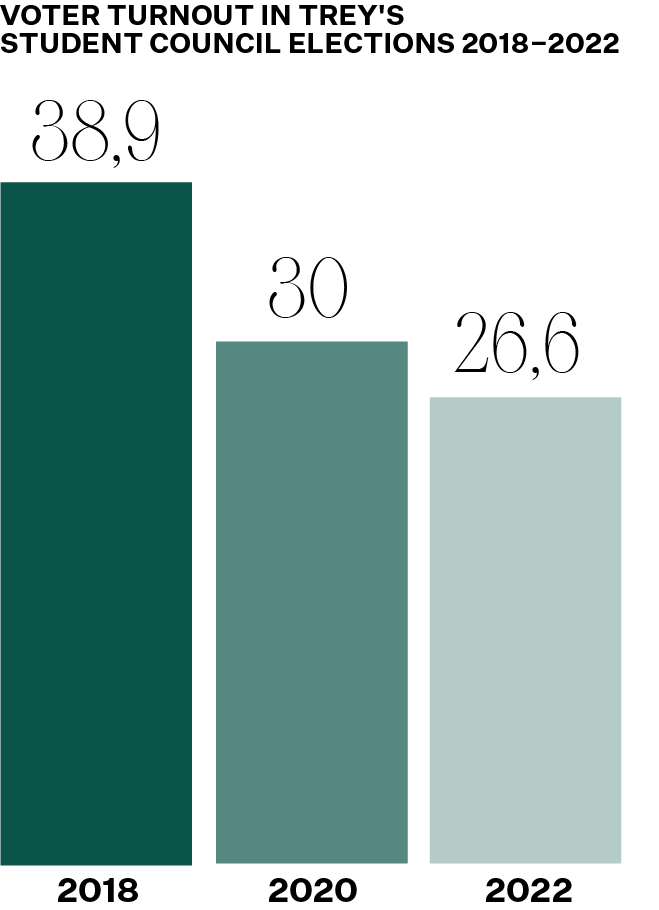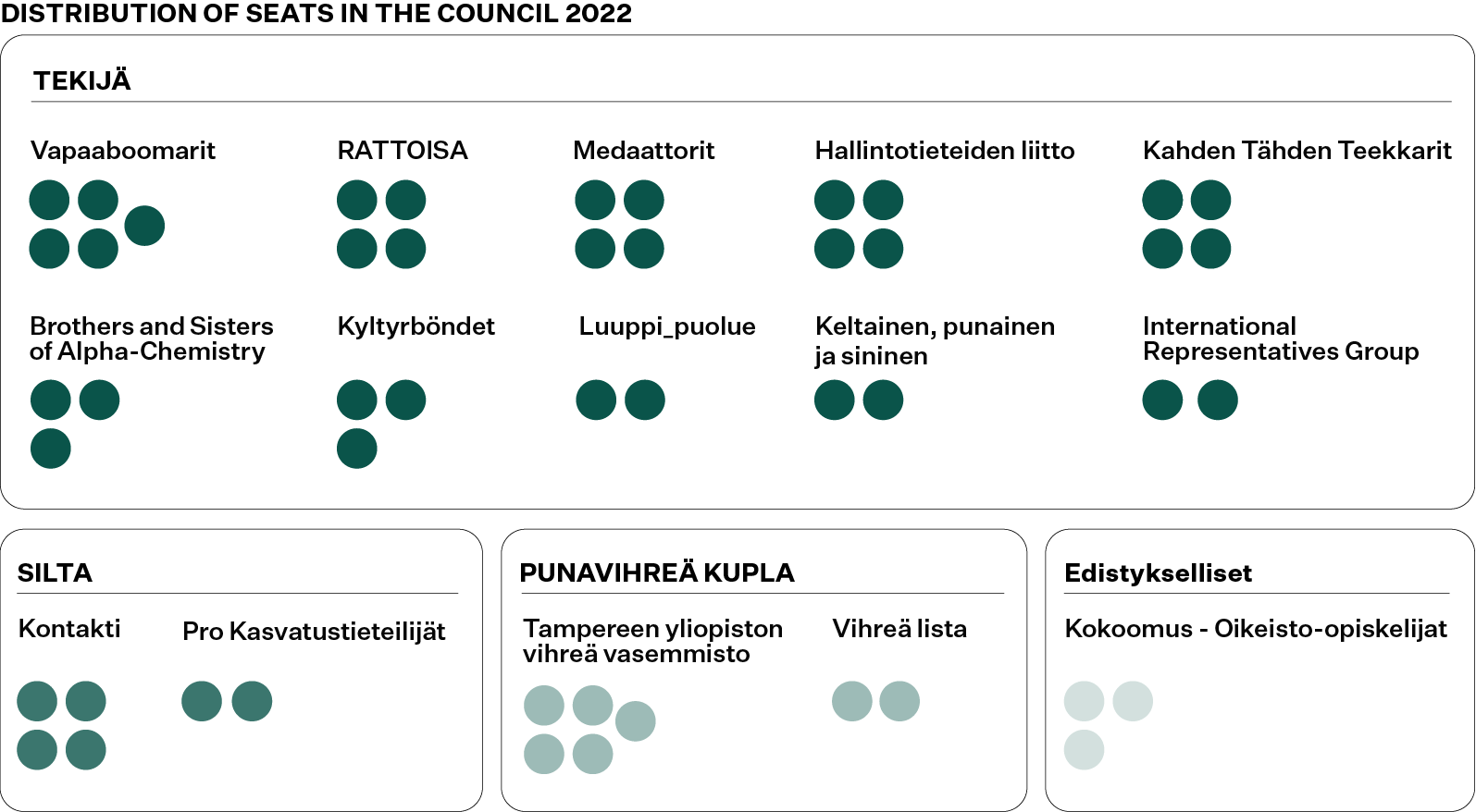The Council of Representatives makes decisions about TREY’s finances and services – read the basics about the council here before this Autumn’s elections
Based on the turnout, not many students are interested in the Representative Council Elections. In this article, we’ll go through what the elections are about and why you should be interested.
Original text: Editorial staff
Graphics: Pauliina Lindell
Translation: Oskari Koski
This autumn, the Student Union of Tampere University (TREY) will hold its third Representative Council Election since the merger election in 2018.
The Representative Council consists of council members. They decide about the Student Union’s matters, such as the make-up of the board of TREY, as well as the strategy and finances of the Student Union.
In addition to policies, the Council of Representatives also decides about matters that directly impact the membership. This includes member services, such as the student magazine Visiiri, developing the student culture, and deciding about the membership fee of the Student Union. This academic year, the membership fee for Bachelor’s or Master’s degree students is 65 euros.
This term, one of the Representative Council’s principal tasks included updating the Policy Paper. The Policy Paper dictates TREY’s policies and goals, both within the University as well as outside it.
The Representative Council has also given motions and resolutions. These include, among others, studying the utilisation rate of the Student Union’s services, in particular for Visiiri, as well as assessments relating to membership in the Finnish Student Sports Federation (OLL).
At the moment, Visiiri’s editorial board, which is subordinate to the Representative Coundil, is preparing an inquiry into a reader assessment.
The Representative Council also makes decisions about the Student Union’s property. During the previous term, it decided to sell the student union’s property located in Pienteollisuustalo.
There are 49 seats in the Representative Council and 147 deputy representatives are also chosen, which means that there needs to be at least 196 candidates in order to fill each position. There can be a smaller number of deputy members, if there are not enough candidates.
The number of candidates in the previous elections has been around 300-400 persons.
Voters’ choices
In order for democracy to be realised, voters must have enough to choose from. There should be much more candidates than positions to fill.
The amount of candidates depends largely on the work done by the electoral alliances. According to TREY’s election coordinator, Mea Vähä-Jaakkola, there have been some changes made to the Election Rules in order to make it easier for electoral alliances to be formed.
The biggest change is that electoral alliances and rings can be established already during candidate nomination. There are two deadlines for establishing a list, the first of which is there so that TREY can publish the lists and their contact information in different channels.
This way, a student who is interested in running as a candidate can find information about the lists in good time and find an appropriate one, even if they have no prior contacts.
In the previous elections, the complete information about the lists of candidates had to be given to the Student Union in one go. Therefore, the announcement of electoral alliances was done at the last minute in order to maximise the time used to recruit candidates.
Two members are enough to establish an electoral alliance.

A subject-association or a party-political list?
As of the writing of this article, not a single electoral alliance has been formed. The nomination has been open since August 12.
Lists are formed on various principles: they can be based on, for example, party-politics, subject- or hobby associations, or some set of values.
Of the party-political lists, Oikeisto-opiskelijat is linked to Kokoomus. The Green Left’s (ViVa) lists collaborate at a national level, but are not a part of any party.
Association-based lists consist of students from a particulat field, but often they also allow others on their lists.
In 2020’s elections, we also saw a hobby association based Bosa Beer Party -list. Kyltyrböndet-list, for their part, has had candidates from members of invitation-only organisations, such as Blebeijit and Perinneseura.
Some lists date back to the student union Tamy from the old University of Tampere and Tampere University of Technology’s student union TTYY, which were united in 2019 as TREY.
Since some of the lists are linked to hobby associations under TREY, only they have previously has the right to hold stands on TREY’s Hobby- and exercise fair. This year, the fair is held during the final days of the candidate nomination period.
So the Student Union has decided, that in these elections, all electoral alliances can take part in the HALI-fair, irrespective of whether they are association-based.
You can also get more information about electoral alliances on TREY’s websites and on their own communication channels.
Get elected with your friends’ votes
The Representative Council Election is often spoken of as a friend election. Often, those who are already involved in associations get votes from their friends and get elected.
According to Mea Vähä-Jaakkola, there is an attempt to change the situation in these elections. TREY is marketing the elections and has, for example, inquired into whether a notifications could be sent via the student-card application Tuudo.
“Getting the information is not up to whether you follow TREY’s channel on telegram or if you have a friend dragging you along.”
Vähä-Jaakkola compares the Representative Election to municipal elections – according to her, people would vote for their friends in a municipality of 20,000 people as well.
“In a tight community, it is typical that you find your candidate from close,” she says.
TREY’s board members act as organisational sponsors in various associations and try to recruit candidates through those channels as well. The goal is to get candidates from new associations.
“Often, running as a candidate requires that you have some sort of connection to the Student Union. Right now we are trying to plant the seeds so that even the smaller actors in the community will take part.”
Students who are considering running might wonder if they have enough knowhow to work in the Representative Council. Vähä-Jaakkola emphasises, that people studying at the university are already well informed about things.
To apply for the Council, it is not necessary that you know about governance, decision-making or politics in particular.
“It is important, that the diversity of the community is represented in the council.”

TREY is making an effort
In 2018, a merger election was held when TREY’s predecessors Tamy and TTYY formed a new student union. After that, elections have been held on 2020 and 2022.
In the 2022 elections, no election coordinator was hired, which turned out to be a mistake, according to Vähä-Jaakkola.
In addition to adding to the personnel resources, TREY’s board has decided that election marketing and related events will receive a similar budget as in 2018 and 2020, that is to say, around 4,000 euros.
The resources directed towards organising the elections have been variable, but according to Vähä-Jaakkola, TREY has now understood that it requires efforts to effectively distribute information and get people excited for the elections. Raising both the candidate count as well as the voter turnout is the goal of both Vähä-Jaakkola and TREY as a whole.
The nomination of candidates is crucial for the voter turnout. Candidates inspire their friends and acquaintances to vote, so the turnout should rise together with the candidate count.
TREY’s role is, according to Vähä-Jaakkola, to make the nomination and campaigning as easy as possible for associations and lists.
“We want to offer opportunities to be on display and we gather information into an easily accessible form, so that they can concentrate on the campaign work and don’t need to worry about bureaucracy.”
An exceptional election
This autumn’s elections are exceptional, because the Council’s upcoming term will only last a year. Usually, the Council sits for two years at a time, but now the new elections are held already in the autumn of next year. This way, TREY can synchronise their election cycle with other student unions.
“It might be, that a short commitment can even lower the bar for running,” Vähä-Jaakkola contemplates.
The shorter term has an influence on drafting the Policy Paper, at least. Before, the paper has been in force two years at a time, but the current Council decided that the Policy Paper accepted by it is in force until further notice.
“It’s an open question, whether the next council will deal with the Policy Paper at all.”
The Representative Council meets around once a month. The meetings usually start at 4pm and go on for a couple hours. Meetings are preceded by an evening session, where issues that are important for the meeting are discussed.
Therefore, when compared to subject associations, the activities take relatively little time.
In the Council of Representatives, a student has the opportunity to influence the functioning of the University and the Student Union, as well as influence what the Student Union advocates for at a national level in educational policies.
Vähä-Jaakkola doesn’t need long to think of an answer to a question about why it pays to run as a candidate for the Council of Representatives.
“It’s a place to have an influence, to get to know new people and to learn new things. You can leave the university community in a better shape than it was when you got it,” she summarises.
For more information about the elections, visit trey.fi/en/student-union/council-elections.
Important dates regarding the Council Elections
» 29.9.2024: Deadline for candidate nomination and the establishment of election lists.
» 3.10.2024: The Central Election Committee processes the candidate nominations for the first time. Candidates get a chance to make corrections, if there are mistakes.
» 10.10.2024: The Central Election Committee finalises the candidate combinations.
» 30.10.–1.11.2024: Advance voting (electronic voting).
» 4.-6.11.2024: Regular election days (electronic voting).
» 6.11.2024: Election result evening. The Central Election Committee will confirm the election result.
Voter turnout has been low nationwide
The turnout for the Representative Council Elections has long stayed at around 30 percent nationally. Council Elections are held in 13 student unions altogether
According to statistics by the National Union of University Students in Finland (SYL), 2019 had the highest voter turnout since 2001. In 2019, 32.4% of eligible voters casted a vote.
The COVID-pandemic caused a dip in statistic. In 2021 and 2023, voter turnouts were just over 29%.
Together with the student union of the University of Helsinki (HYY), TREY has had a different voting schedule than other student unions in Finland. Other universities have held the elections on odd numbered years, which is why the national statistics about the elections are from last year.
With next year’s early elections, both TREY as well as HYY will move to the same election schedule as other student unions in Finland.
Voter turnout in TREY has been close to the national average, except for the merger election of 2018, when the turnout was 38.91%.
Independent associations are still the biggest group in TREY’s representatives by a large margin.
Also the results in the 2022 elections were similar to the national results last year.
According to SYL, politically independent groups kept their place as the biggest group in the 2023 elections, but political groups did get a total of nine seats more than in the previous elections.
The result for TREY’s elections in 2022 was similar, as the political group the Green Left (ViVa) won the election and grew to become the biggest group together with Vapaaboomarit, with five seats for both of them.
The number of seats by the political groups grew by one, but independent associations are still the biggest group in TREY’s representatives by a large margin.